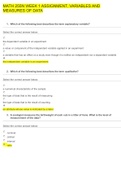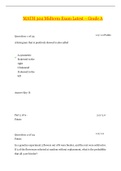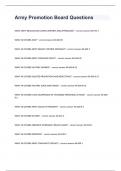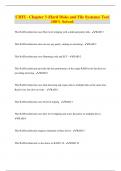Lecture 1 – august 28 – Introductory lecture
Lecture 2 – august 31 – inventory management and risk pooling
Key inventory decisions: How much to order and when to order?
Managing inventory means managing what you need, not more, not less.
Why is inventory required?
- The uncertainty of customer demand: shorter product lifecycles, more competing
products
- Uncertainty in supplies: quality, quantity, costs, delivery times
- Delivery lead times
- Incentives for larger shipments: economies of scale in transportation/purchasing.
Economic Lot Size Model: constant and deterministic demand, infinite planning horizon. The
goal is to minimize annual purchasing and carrying costs. D= demand.
The model is a good starting point, but the demand is uncertain and is not always available.
- The forecast is always wrong since it is difficult to match supply and demand
- The longer the forecast horizon, the worse the forecast. It is even more difficult if one
needs to predict customer demand for a long period of time or much ahead of the
selling season.
- Aggregate forecasts are more accurate. It is more difficult to predict customer
demand for individual products, it is much easier to predict demand across a product
category.
Single period models: one ordering opportunity only before demand occurs, based on
historical data. Determine the probability each of these scenarios to occur.
How much to order? Above, below or equal to the expected demand? calculate the average
given an expected order quantity.
Risk pooling:
Key idea: demand variability is reduced if one aggregates demand.
Inventory models: how much inventory to put at a single location to serve demand?
In how many different locations should the firm store inventory to serve demand?
Demand variability (CV) is reduced if one aggregates demand across locations.
,More likely that high demand from one customer will be offset by low demand from
another.
Coefficient of variation = st dev / mean demand
The higher the initial coefficient of variation, the greater the benefit from location pooling
The benefits from location pooling depend on the behavior of the demand from one market
relative to demand from another
Reallocation of items from one market to another easily accomplished in centralized
systems
Other forms of risk-pooling:
- Standardized design (=product pooling): product category demand is easier to
predict. Aggregate forecasts are more accurate than individual product forecasts.
- Delayed differentiation (postponement): delay of product differentiation until closer
to the sale of the product.
- Product flexibility (capacity pooling): produce multiple products/models in one
factory. Adding flexibility increases capacity utilization and expected sales.
Marginal profit/unit = selling price – variable ordering (or production) cost
Marginal cost/unit = variable ordering (or production) costs – salvage value
If the marginal profit > marginal costs optimal quantity > average demand
If the marginal profit < marginal costs optimal quantity < average demand
in this example I order (12,000 units) below the average demand (13,000 units) since the
marginal profit is smaller than the marginal costs.
The optimal service level (SL) = (marginal profit) / (marginal profit + marginal cost)
= order quantity
Multiple Order Opportunities
- Continuous review policy: If the manufacturer has an initial inventory, he should wait
to reach a reorder point before placing an order for Q units. The reorder point should
satisfy the demand during lead time and protect against demand uncertainty.
, R = reorder point
L = lead time??
Andere afkortingen??
The order quantity (Q) shall balance inventory holding
costs and fixed order costs
- Periodic review policy: the inventory level is reviewed
periodically at regular intervals. This can be done on short intervals (ex. Daily) (policy)
or at longer intervals (ex. weekly or monthly) (base stock level policy).
Policy: during each inventory review, if the inventory position falls below s, order
enough to raise the inventory position to S. Set s=R and S=R+Q
Base-stock level policy: always order after an inventory level review. Determine a
target inventory level, the base-stock level. During each review period, the
inventory position is reviewed. Order enough to raise the inventory position to
the base-stock level.
How to determine the base-stock level?
Risk pooling: the practice of sharing all risks among a group of products on one single
location.
- Inventory models: how much inventory to put at a single location to serve demand?
- Equally important decisions: In how many different locations should the firm store
inventory to serve demand?
- Risk (location) pooling: Demand variability is reduced if one aggregates demand
across locations
The higher the initial coefficient of variation, the greater the benefit from location pooling
(in the example, product B would benefit the most for location pooling).
Risk pooling benefits are higher in situations where demands observed at warehouses are
negatively correlated.
Reallocation of items from one market to another is easily accomplished in centralized
systems.
, Echelon inventory is the inventory level between any particular stage in the supply chain
and the final customer.
Lecture 3 – Supply contracts – September 4th
2-stage supply chain: make-to-order (MTO). P = selling price, W= wholesale price, S =
salvage price.
The sum of the retailer’s profit and the manufacturer’s profit is the total supply chain profit.
By producing the order quantity with the highest supply chain profit, the risk of leftover
inventory increases.
Optimal service level: Cu = cost of understocking, co =
cost over overstocking.
How can you arrange a contract in which the supplier shares some risk with the buyer?
- Buy-back contract: Supplier agrees to buy back unsold goods from the buyer for
some agreed-upon price. Order size increases.
- Revenue sharing contract: the buyer shares some of its revenue with the supplier in
return for a discount on the wholesale price. The buyers cost and revenue are lower.
The order size increased and the total expected profit for the total supply chain
increases.
- Quantity-flexibility contracts: suppliers provide full refund for returned (unsold)
items, as long as the number of returns is no larger than a certain quantity.
- Sales Rebate Contracts: a rebate is paid by the supplier for any item sold above a
certain quantity.
Lecture 2 – august 31 – inventory management and risk pooling
Key inventory decisions: How much to order and when to order?
Managing inventory means managing what you need, not more, not less.
Why is inventory required?
- The uncertainty of customer demand: shorter product lifecycles, more competing
products
- Uncertainty in supplies: quality, quantity, costs, delivery times
- Delivery lead times
- Incentives for larger shipments: economies of scale in transportation/purchasing.
Economic Lot Size Model: constant and deterministic demand, infinite planning horizon. The
goal is to minimize annual purchasing and carrying costs. D= demand.
The model is a good starting point, but the demand is uncertain and is not always available.
- The forecast is always wrong since it is difficult to match supply and demand
- The longer the forecast horizon, the worse the forecast. It is even more difficult if one
needs to predict customer demand for a long period of time or much ahead of the
selling season.
- Aggregate forecasts are more accurate. It is more difficult to predict customer
demand for individual products, it is much easier to predict demand across a product
category.
Single period models: one ordering opportunity only before demand occurs, based on
historical data. Determine the probability each of these scenarios to occur.
How much to order? Above, below or equal to the expected demand? calculate the average
given an expected order quantity.
Risk pooling:
Key idea: demand variability is reduced if one aggregates demand.
Inventory models: how much inventory to put at a single location to serve demand?
In how many different locations should the firm store inventory to serve demand?
Demand variability (CV) is reduced if one aggregates demand across locations.
,More likely that high demand from one customer will be offset by low demand from
another.
Coefficient of variation = st dev / mean demand
The higher the initial coefficient of variation, the greater the benefit from location pooling
The benefits from location pooling depend on the behavior of the demand from one market
relative to demand from another
Reallocation of items from one market to another easily accomplished in centralized
systems
Other forms of risk-pooling:
- Standardized design (=product pooling): product category demand is easier to
predict. Aggregate forecasts are more accurate than individual product forecasts.
- Delayed differentiation (postponement): delay of product differentiation until closer
to the sale of the product.
- Product flexibility (capacity pooling): produce multiple products/models in one
factory. Adding flexibility increases capacity utilization and expected sales.
Marginal profit/unit = selling price – variable ordering (or production) cost
Marginal cost/unit = variable ordering (or production) costs – salvage value
If the marginal profit > marginal costs optimal quantity > average demand
If the marginal profit < marginal costs optimal quantity < average demand
in this example I order (12,000 units) below the average demand (13,000 units) since the
marginal profit is smaller than the marginal costs.
The optimal service level (SL) = (marginal profit) / (marginal profit + marginal cost)
= order quantity
Multiple Order Opportunities
- Continuous review policy: If the manufacturer has an initial inventory, he should wait
to reach a reorder point before placing an order for Q units. The reorder point should
satisfy the demand during lead time and protect against demand uncertainty.
, R = reorder point
L = lead time??
Andere afkortingen??
The order quantity (Q) shall balance inventory holding
costs and fixed order costs
- Periodic review policy: the inventory level is reviewed
periodically at regular intervals. This can be done on short intervals (ex. Daily) (policy)
or at longer intervals (ex. weekly or monthly) (base stock level policy).
Policy: during each inventory review, if the inventory position falls below s, order
enough to raise the inventory position to S. Set s=R and S=R+Q
Base-stock level policy: always order after an inventory level review. Determine a
target inventory level, the base-stock level. During each review period, the
inventory position is reviewed. Order enough to raise the inventory position to
the base-stock level.
How to determine the base-stock level?
Risk pooling: the practice of sharing all risks among a group of products on one single
location.
- Inventory models: how much inventory to put at a single location to serve demand?
- Equally important decisions: In how many different locations should the firm store
inventory to serve demand?
- Risk (location) pooling: Demand variability is reduced if one aggregates demand
across locations
The higher the initial coefficient of variation, the greater the benefit from location pooling
(in the example, product B would benefit the most for location pooling).
Risk pooling benefits are higher in situations where demands observed at warehouses are
negatively correlated.
Reallocation of items from one market to another is easily accomplished in centralized
systems.
, Echelon inventory is the inventory level between any particular stage in the supply chain
and the final customer.
Lecture 3 – Supply contracts – September 4th
2-stage supply chain: make-to-order (MTO). P = selling price, W= wholesale price, S =
salvage price.
The sum of the retailer’s profit and the manufacturer’s profit is the total supply chain profit.
By producing the order quantity with the highest supply chain profit, the risk of leftover
inventory increases.
Optimal service level: Cu = cost of understocking, co =
cost over overstocking.
How can you arrange a contract in which the supplier shares some risk with the buyer?
- Buy-back contract: Supplier agrees to buy back unsold goods from the buyer for
some agreed-upon price. Order size increases.
- Revenue sharing contract: the buyer shares some of its revenue with the supplier in
return for a discount on the wholesale price. The buyers cost and revenue are lower.
The order size increased and the total expected profit for the total supply chain
increases.
- Quantity-flexibility contracts: suppliers provide full refund for returned (unsold)
items, as long as the number of returns is no larger than a certain quantity.
- Sales Rebate Contracts: a rebate is paid by the supplier for any item sold above a
certain quantity.










